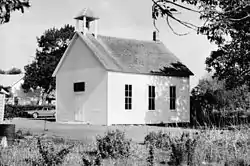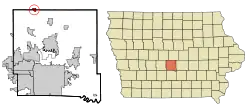Sheldahl, Iowa
Sheldahl is a city in Polk, Boone, and Story counties in the U.S. state of Iowa. The population was 297 at the time of the 2020 census.[3]
Sheldahl, Iowa | |
|---|---|
 | |
 Location of Sheldahl, Iowa | |
| Coordinates: 41°51′51″N 93°41′47″W | |
| Country | |
| State | |
| Counties | Story, Polk, Boone |
| Government | |
| • Mayor | Don Towers |
| Area | |
| • Total | 0.80 sq mi (2.08 km2) |
| • Land | 0.80 sq mi (2.08 km2) |
| • Water | 0.00 sq mi (0.00 km2) |
| Elevation | 1,030 ft (310 m) |
| Population (2020) | |
| • Total | 297 |
| • Density | 370.32/sq mi (142.93/km2) |
| Time zone | UTC-6 (Central (CST)) |
| • Summer (DST) | UTC-5 (CDT) |
| ZIP code | 50243 |
| Area code | 515 |
| FIPS code | 19-72345 |
| GNIS feature ID | 2395867[2] |
The Boone County portion of Sheldahl is part of the Boone Micropolitan Statistical Area, while the Story County portion is part of the Ames Metropolitan Statistical Area. Together, these two areas form the Ames–Boone Combined Statistical Area. The small portion of the city that extends into Polk County is part of the Des Moines–West Des Moines Metropolitan Statistical Area.
History
The area was settled by 120 Norwegian immigrants from Lisbon, Illinois on June 7, 1855; including Osmond and Anna Sheldahl and five of their children. It incorporated as a city on January 18, 1882.[4]
The Chicago and Northwestern Railway[5] established a NE to S rail line through Sheldahl during the 1880s. The Chicago, Milwaukee, St. Paul, and Pacific Railroad connected with this line 2 miles north in Slater. In 2005, Union Pacific Railroad sold a 25-mile discontinued rail corridor—which included the recently abandoned line through Sheldahl—to the Iowa Natural Heritage Foundation, which enabled the construction of the recreational High Trestle Trail. Access to the trail, including a parking area and washroom, is located in Sheldahl.[6]
Geography
According to the United States Census Bureau, the city has a total area of 0.84 square miles (2.18 km2), all land.[7]
Demographics
| Year | Pop. | ±% |
|---|---|---|
| 1900 | 179 | — |
| 1910 | 202 | +12.8% |
| 1920 | 175 | −13.4% |
| 1930 | 209 | +19.4% |
| 1940 | 206 | −1.4% |
| 1950 | 211 | +2.4% |
| 1960 | 279 | +32.2% |
| 1970 | 285 | +2.2% |
| 1980 | 315 | +10.5% |
| 1990 | 315 | +0.0% |
| 2000 | 336 | +6.7% |
| 2010 | 319 | −5.1% |
| 2020 | 297 | −6.9% |
| Source:"U.S. Census website". United States Census Bureau. Retrieved March 28, 2020. and Iowa Data Center Source: | ||
2010 census
As of the census[9] of 2010, there were 319 people, 124 households, and 98 families living in the city. The population density was 379.8 inhabitants per square mile (146.6/km2). There were 132 housing units at an average density of 157.1 per square mile (60.7/km2). The racial makeup of the city was 98.7% White, 0.3% Native American, and 0.9% from two or more races. Hispanic or Latino of any race were 0.9% of the population.
There were 124 households, of which 31.5% had children under the age of 18 living with them, 62.1% were married couples living together, 11.3% had a female householder with no husband present, 5.6% had a male householder with no wife present, and 21.0% were non-families. 16.1% of all households were made up of individuals, and 8.1% had someone living alone who was 65 years of age or older. The average household size was 2.57 and the average family size was 2.84.
The median age in the city was 42.3 years. 25.4% of residents were under the age of 18; 5.7% were between the ages of 18 and 24; 23.3% were from 25 to 44; 29.4% were from 45 to 64; and 16.3% were 65 years of age or older. The gender makeup of the city was 50.8% male and 49.2% female.
2000 census
As of the census[10] of 2000, there were 336 people, 129 households, and 99 families living in the city. The population density was 398.5 inhabitants per square mile (153.9/km2). There were 132 housing units at an average density of 156.6 per square mile (60.5/km2). The racial makeup of the city was 99.70% White, 0.30% from other races. Hispanic or Latino of any race were 0.30% of the population.
There were 129 households, out of which 34.1% had children under the age of 18 living with them, 65.9% were married couples living together, 6.2% had a female householder with no husband present, and 22.5% were non-families. 18.6% of all households were made up of individuals, and 9.3% had someone living alone who was 65 years of age or older. The average household size was 2.60 and the average family size was 2.96.
26.2% are under the age of 18, 6.5% from 18 to 24, 28.6% from 25 to 44, 25.6% from 45 to 64, and 13.1% who were 65 years of age or older. The median age was 37 years. For every 100 females, there were 103.6 males. For every 100 females age 18 and over, there were 105.0 males.
The median income for a household in the city was $48,393, and the median income for a family was $48,571. Males had a median income of $32,969 versus $25,000 for females. The per capita income for the city was $17,811. About 5.7% of families and 3.4% of the population were below the poverty line, including 2.0% of those under age 18 and none of those age 65 or over.
Education
The community is within the North Polk Community School District.[11]
Notable people
References
- "2020 U.S. Gazetteer Files". United States Census Bureau. Retrieved March 16, 2022.
- U.S. Geological Survey Geographic Names Information System: Sheldahl, Iowa
- "2020 Census State Redistricting Data". census.gov. United states Census Bureau. Retrieved August 12, 2021.
- Henning, Barbara Beving Long; Patrice K. Beam (2003). Des Moines and Polk County: Flag on the Prairie. Sun Valley, California: American Historical Press. ISBN 1-892724-34-0.
- Walker, Mike; SPV Comprehensive Railroad Atlas of North America; Prairies East and Ozarks (Iowa, Missouri, and Arkansas); ISBN 1 874745 17 X; Map IA-7; p. 26; Copyright 2004
- "High Trestle Trail". Polk County, Iowa.
- "US Gazetteer files 2010". United States Census Bureau. Archived from the original on January 25, 2012. Retrieved May 11, 2012.
- "Census of Population and Housing". Census.gov. Retrieved June 4, 2015.
- "U.S. Census website". United States Census Bureau. Retrieved May 11, 2012.
- "U.S. Census website". United States Census Bureau. Retrieved January 31, 2008.
- "North Polk" (PDF). Iowa Department of Education. Retrieved April 2, 2020.